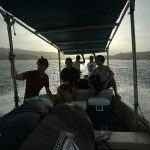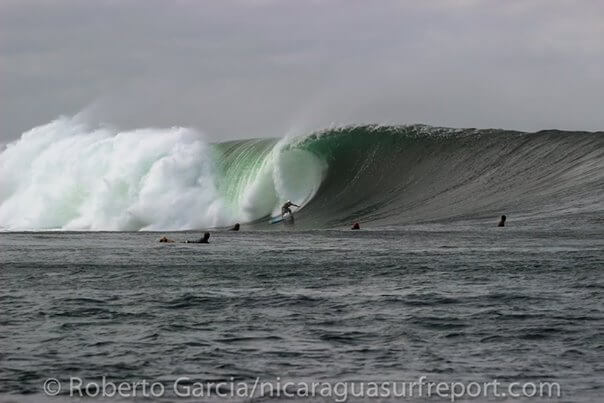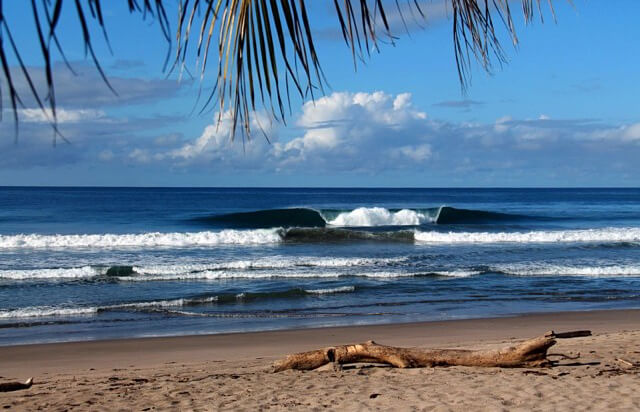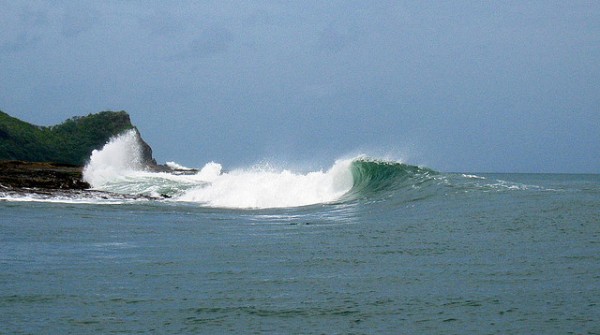6 best surf spots in Nicaragua
Categories: Beaches, community, La Playa, Oceans, Photo, Sand, Sun, Travel
Nicaraguan waves rank among the best in Central America. Trade winds blow unopposed over Lake Managua and out into the Pacific, blessing the southwestern coastline with consistently offshore winds. Add to that the fact that the country receives the brunt of storm waves propagating up from the South Pacific year round, and has a coastal topography littered with points, reefs, and creek-fed beaches.
What this means is, on any given day, somewhere in Nicaragua, it’s going off.
When to go
The dry season (December – April) sees less frequent swells from the South Pacific, but the wind is more reliably offshore (that said, the offshores will blow too hard sometimes). If you’re learning, or just want to surf mellow beaches, go during this time. The wet season (May – November) sees less predictable winds (there can be onshores for weeks at a time), but a constant influx of solid swells. This is when the points and reefs come alive, and the experienced surfers roll in with semi-guns.
Also, check the moon phases and avoid the times of full and new moon. The waves in Nicaragua are all very tide dependent, and generally speaking, the less extreme the tidal swings, the better. Try to time your trip on the smaller tide weeks.
1. Playa Maderas
The wind is usually perfect at Maderas, as it’s situated adjacent to Lake Managua. It’s a beach offering hollow lefts and rights that handles long period swells quite well. A 10-minute drive on rough roads from San Juan del Sur, it’s the go-to place for both tourists and locals (shuttles from $5).
There are quite a few surf schools, so if you’re just learning start here. That said, Maderas holds plenty of size and is awesome for experienced surfers too. Stay at one of the budget options on the beach and wake up early to beat the crowds.
2. Popoyo
Popoyo is really two spots: the inner reef and outer reef. The inside is a left breaking over coral heads and urchins and other things you don’t want anything to do with. Try not to break your fins. Watch the nicaragüenses make the tricky paddle out through the reef before you attempt it. It gets heavy and tends to max out. The inner reef is one of the classic surf spots in Nica and the local expat contingent and dedicated campers have this place on lockdown. Bring patience and timing.
The outer reef is for pros (or crazy people). When the swell pushes past six or seven feet, head here. Bring your gun, or the ski to tow in. Expect machine-like barrels throwing as wide as they are tall and breaking at about three to five times overhead, over a scary-shallow reef. I’m nominating it as the heaviest wave in Nica.
3. Playa Colorado
Once a quiet swath of arid tropical forest outside Rivas, Playa Colorado now has a private gated condominium resort, complete with golf course, and caters to affluent Americans shuttling into the second most impoverished nation in the world. Granted, if you have the cash ($200/night), you too can rent a luxury vacation house right in front of one of Central America’s punchiest beach breaks. Sediment flux from the river mouth creates perfect sandbanks. And with the offshore winds, and how it works on all tides, this wave is barreling all the time. Beyond 3ft, leave it to the advanced surfers.
For much cheaper accommodation, and to learn Spanish and the Nica way of life, stay in Playa Gigante — homestays with the locals can be arranged in town, and there are also a number of work exchanges available for budget travelers at the Hotel Brio and Camino del Gigante Hostel. You can hike (30 min) to Colorado or hire pangas (from $6pp) from there.
4. Panga Drops
Panga’s got its name when an inattentive boat captain accidentally got his panga (small power boat) caught inside. Surfers know this place is a wave magnet and unusually large sets come out of nowhere and hand out beatings. The panga didn’t fare so well — it got caught in the lip and thrown over the falls, down into the reef where it remained for a few days.
Bring a semi-gun and surf here when it’s smaller. Mind the huge rips and wait out the bombs. Is this wave crowded? No way, it’s too wild. Hire a fisherman to take you from Playa Gigante. It’s just north of Playa Colorado.
5. Lance’s Left
The great left point wave is no longer a secret. Difficult access requires hiring a boat from Playa Gigante or Astillero, but it’s possible to hike in from Astillero. Lance’s breaks off a rocky headland which also shelters the wave from hard offshores. It works best on large swells — if all the beaches are maxed out, try here. Rides from 50-70 meters are the norm.
The wave walls up nicely and offers a mix of racy barrels and big shoulders for cutbacks. This wave very rarely gets crowded. Enjoy it while it lasts. There are numerous lodging options in Astillero.
6. The Boom
The Boom is a particularly heavy beach. If you want ledges, over-vertical drop-ins, sucking flats…if you want really gnarly barrels, go here. It’s a wide stretch of beach with plenty of peaks to choose from, located in Aseradores, a tiny pueblo beyond Chinandega. You won’t find many other tourists around aside from surfers.
Being north of Lake Managua, the wind’s not offshore all day here — only in the mornings. The area is very isolated and quiet so bring some books for the insane amount of time you’ll spend in a hammock. Stay and eat at Joe’s Place ($7/night).




No comments yet.